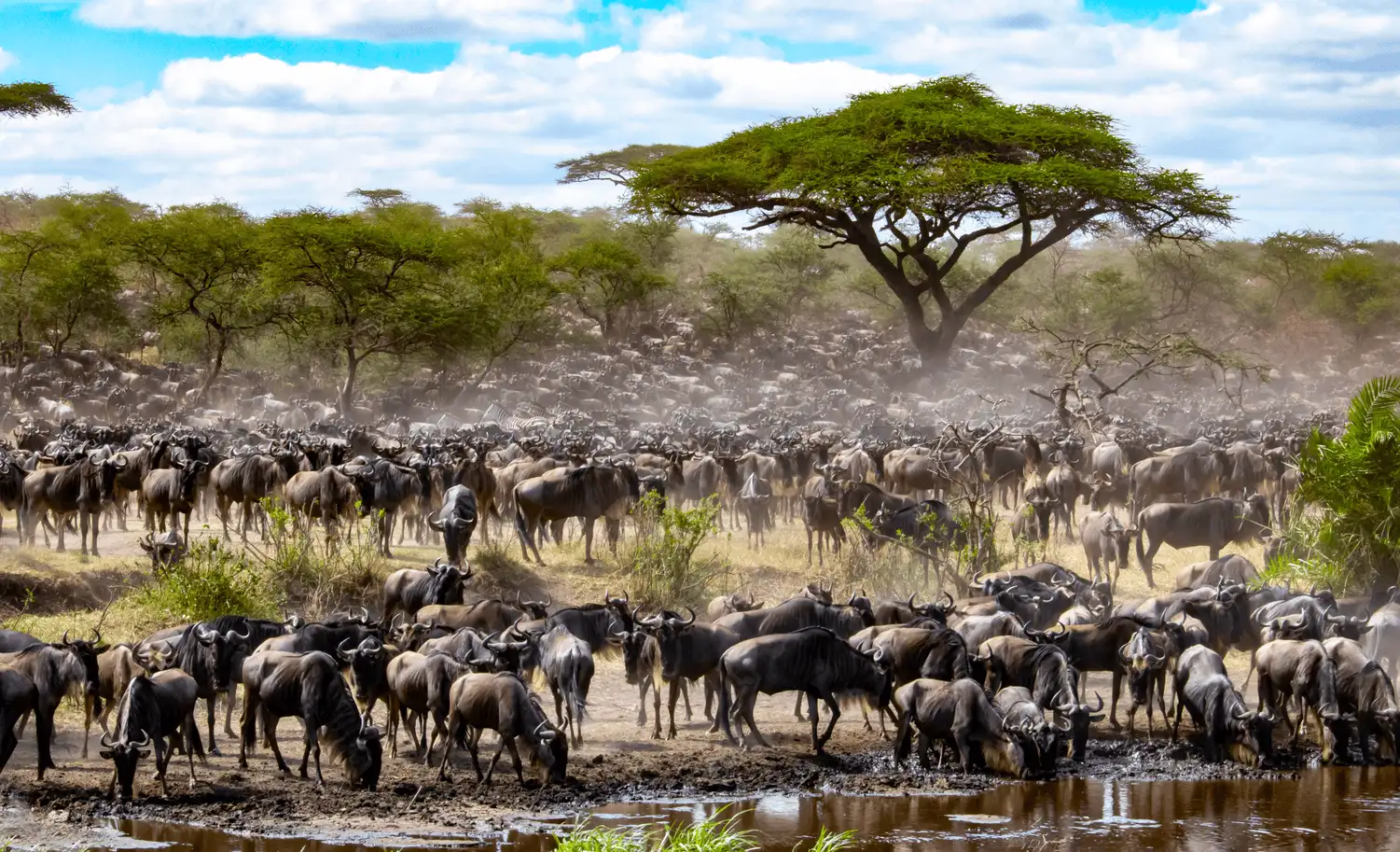Call / Chat : +255 754 755 785 | info@way2africaexpeditions.com
The Great Migration
Home > The Great Migration

The Great Migration in the Serengeti National Park: Nature’s Grandest Show
By Way 2 Africa Expeditions, Arusha, Tanzania
The Great Migration is one of the most spectacular natural events on Earth, a breathtaking phenomenon that showcases the raw power of nature and the survival instincts of millions of animals. Each year, over 1.5 million wildebeest, accompanied by hundreds of thousands of zebras and gazelles, embark on a relentless journey across the Serengeti National Park in Tanzania and the Maasai Mara in Kenya. At Way 2 Africa Expeditions, we invite you to witness this awe-inspiring event with us, as we guide you through the entire cycle, share interesting facts, and highlight the best times to experience this remarkable spectacle.
The Cycle of the Great Migration
The Great Migration is a continuous, year-round cycle driven by the search for fresh grazing and water. The journey follows a roughly clockwise pattern, with the animals traveling across vast distances and facing numerous challenges along the way.
- January to March: Calving Season in the Southern Serengeti
The journey begins in the southern Serengeti, particularly in the Ndutu region of the Ngorongoro Conservation Area, where the wildebeest herds gather on the nutrient-rich short grass plains. From late January to March, this area becomes the stage for the calving season, where over 500,000 calves are born within a few weeks. The abundance of vulnerable newborns attracts predators such as lions, cheetahs, and hyenas, making this an exciting time to witness dramatic predator-prey interactions.
- April to June: The Long Trek Northward
As the rains begin to taper off, the herds start moving northward towards the central Serengeti and the Western Corridor. April and May see the wildebeest migrating through Moru Kopjes and into the Grumeti River area. By June, the herds have reached the Grumeti River, where they must navigate treacherous river crossings. The Grumeti River, home to giant crocodiles, becomes a deadly obstacle as the wildebeest plunge into the waters, providing heart-pounding action for those lucky enough to witness it.
- July to October: The Mara River Crossings
By July, the herds have reached the northern Serengeti, where they prepare to cross the Mara River into the Maasai Mara in Kenya. The Mara River crossings are the most iconic and dramatic events of the Great Migration. The wildebeest face not only the strong currents of the river but also the lurking crocodiles, making these crossings a thrilling yet perilous part of their journey. The crossings continue into August and September, with the herds dispersing across the Mara plains in search of greener pastures.
- November to December: The Return to the Serengeti
As the short rains arrive in November, the herds begin their southward journey back to the Serengeti. The wildebeest return to the southern plains, completing the cycle and beginning the process anew. The landscape is lush and green, providing ample food for the animals as they prepare for another calving season. The migration is a continuous cycle of life and death, with each year bringing new challenges and triumphs.
What makes this Grand Event Special?
- Largest Land Migration: The Great Migration is the largest terrestrial mammal migration in the world, with over 1.5 million wildebeest, 200,000 zebras, and 300,000 gazelles participating each year.
- Instinct-Driven: The migration is driven by the animals’ instincts to follow the rains and find fresh grazing. This incredible journey covers approximately 1,800 miles annually.
- Predator-Prey Drama: The migration attracts numerous predators, including lions, leopards, cheetahs, and hyenas. The abundance of prey during the calving season and river crossings leads to intense predator-prey interactions.
- Survival of the Fittest: Not all animals survive the migration. Thousands of wildebeest die from exhaustion, drowning, predation, and injuries along the way, highlighting the harsh realities of the natural world.
- Communication: Wildebeest communicate through vocalizations and visual signals, such as raising their tails, to alert the herd of danger or coordinate movement.
Best Time to Experience the Great Migration
The Great Migration is a year-round event, but the best time to experience specific parts of the migration depends on what you wish to see:
- Calving Season (January to March): Visit the southern Serengeti for the calving season, where you can witness the birth of thousands of wildebeest calves and dramatic predator activity.
- Grumeti River Crossings (May to June): Travel to the western Serengeti to witness the Grumeti River crossings, where wildebeest brave crocodile-infested waters.
- Mara River Crossings (July to October): Head to the northern Serengeti for the iconic Mara River crossings, where the herds face the ultimate challenge of their journey.
- Returning Migration (November to December): Experience the herds’ return to the southern Serengeti as they prepare for the next calving season.
Why Choose Way 2 Africa Expeditions?
At Way 2 Africa Expeditions, we specialize in creating unforgettable safari experiences that bring you up close to the wonders of the Great Migration. Our expert guides, luxury accommodations, and customized itineraries ensure that you witness the migration at its best, whether you’re looking for thrilling predator encounters, scenic landscapes, or the iconic river crossings.
Plan Your Great Migration Safari Today
The Great Migration is a bucket-list event that every wildlife enthusiast should experience. Contact Way 2 Africa Expeditions today to start planning your journey into the heart of the Serengeti, where nature’s grandest show awaits.
Karibu sana (welcome), and let the adventure of a lifetime begin!
Write Us a Review

Contact Us
- Way 2 Africa Expeditions
- Way 2 Africa Expeditions
- @way_2_africa_expeditions
- info@way2africaexpeditions.com
- +255 784 241 648 / +255 754 755 785
- +255 784 241 648 / +255 754 755 785
- Arusha, Tanzania
We Accept


